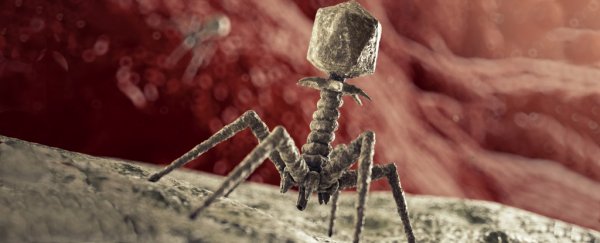In the world of microbial warfare, sometimes you have to change the very fabric of who you are.
Viruses that infect bacteria – fittingly called bacteriophages - and their prey have been at war for eons, each side evolving more devilish tactics to infect or destroy each other. Eventually, some bacteriophages took this arms race to a new level by changing the way they code their DNA.
At least, that's what we think happened. Once thought to be an outlier, new research published in three separate papers shows that there's a whole army of bacteriophages with non-standard DNA, which researchers call a Z-genome.
"Genomic DNA is composed of four standard nucleotides … These nucleobases form the genetic alphabet, ATCG, which is conserved across all domains of life," biologists Michael Grome and Farren Isaacs write in a recent Science editorial accompanying the new research on bacteriophage genetics.
"However, in 1977, the DNA virus cyanophage S-2L was discovered with all instances of 'A' substituted with 2-aminoadenine (Z) throughout its genome forming the genetic alphabet ZTCG."
The reason appeared to be self-protection. Within the connecting 'rungs' of a DNA double helix, the 'Z' base forms a triple bond to the opposite 'T' base, one more than the two bonds of the regular A:T connection. This makes the viral genome hardier and more difficult for bacteria to prise apart with chemicals called nucleases.
Although scientists were fascinated, no other bacteriophages were found with the Z-genome, and with the difficulty of culturing S-2L in a lab, the Z-genome was set aside as a curiosity.
Now, research documented in three separate studies from researchers in France and China shows that this was not a one-off, whilst also characterizing how the Z-genome works and how it's assembled.
"Scientists have long dreamed of increasing the diversity of bases. Our work shows that nature has already come up with a way to do that," one of the teams, led by first author Yan Zhou from Tianjin University, wrote in their paper.
Zhou's team, along with another group led by Institut Pasteur microbiologist Dona Sleiman, found two major proteins which they called PurZ and PurB; these make up the 'Z' base.
A third group, led by Université Paris-Saclay synthetic biologist Valerie Pezo, corroborated those findings and analysed an enzyme – called DpoZ – which is responsible for assembling the whole Z-genome together.
All three searched genetic sequence databases for the sequences relating to their proteins and enzymes, and found a wide variety of bacteriophages with similar genes.
"[The authors] have done an amazingly comprehensive job of showing that this is not one crazy outlier, but there's a whole group of bacteriophages that have this kind of genetic material," Jef Boeke, a molecular biologist at New York University who was not involved in the work, told The Scientist.
There are still plenty of questions to answer about the Z-genome.
For example, is a Z-genome compatible with regular cell machinery such as ours? And could it be used in the same way that artificial DNA is starting to be?
"The Z base has been unambiguously identified in a carbonaceous meteorite and proposed as a nucleobase that could have been available for the origin of life," the team lead by Zhou wrote in their paper.
"Considering that the Z base was discovered in a meteorite, our work may spark interest in interdisciplinary research on the origins of life and astrobiology."
The three papers have been published in Science here, here, and here.
